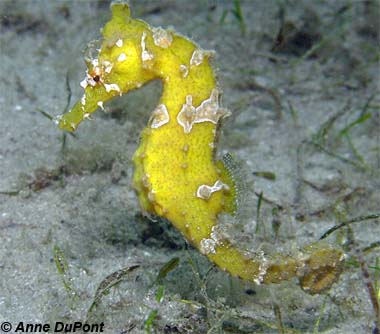
Hippocampus erectus
These specialized fish are poor swimmers and rely on their coloring and texture to camouflage themselves among coral, seagrass, or mangroves where they ambush much smaller prey by sucking them into their toothless snouts. They choose a mate for a season or a lifetime, have complex courting and bonding rituals, and the male carries the embryos to term in his brood pouch. The lined seahorses grow to over 7 inches long and live one to four years. Because of their excellent camouflage, and their body structure of bony plates, they have little danger of predation, but humans collect them for traditional medicine and the aquarium trade.
Order – Syngnathiformes
Family – Syngnathidae
Genus – Hippocampus
Species – erectus
Common Names
English language common names are lined seahorse, horsefish, northern seahorse, sea horse, seahorse, spotted sea horse, and spotted seahorse. Other common names include Amerikansk Jättesjöhäst (Swedish), caballito punteado (Spanish), caballito estriado (Spanish),caballito erecto (Spanish), caballito de mar (Spanish), cavalo-marinho (Portuguese), cavalo-do-mar (Portuguese), cavalinho-do-mar (Portuguese), cabai di awa (Papiamento), hippocampe rayé (French), vestatlantisk søhest (Danish), and zeepaardje (Dutch).
Importance to Humans
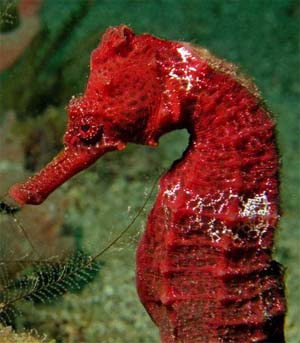
Seahorses are not targeted in fisheries in the western Atlantic Ocean, however they are a targeted fish in other regions where they are commonly traded for ornamental display, aquarium fishes, and traditional Chinese medicine. It is also commonly taken as bycatch in the shrimp trawl and other fisheries off of Florida, Mexico, Central America, and South America. It is also susceptible to habitat degradation due to coastal development and marine pollution.
Conservation
The lined seahorse is listed by the World Conservation Union (IUCN) Red List as “Vulnerable” due primarily to indirect evidence that numbers are continuing to decline which has raised concern. In addition, all species within the genus of Hippocampus were listed in Appendix II of CITES in 2002. In Florida, this species is targeted within the aquarium trade fishery which is monitored and regulated by the state including a limitation on the number of commercial harvesters. However, non-selective in not monitored in any state.
> Check the status of the lined seahorse at the IUCN website.
Geographical Distribution
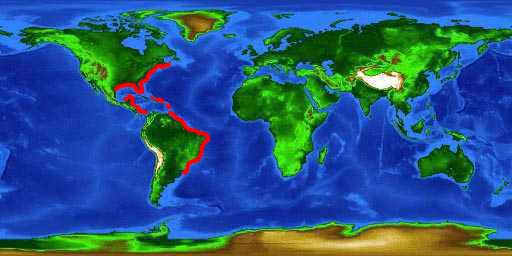
This seahorse is found from Cape Cod (and rarely Nova Scotia, Canada) southward to Bermuda, the Bahamas, shores of the Gulf of Mexico, Cuba, Haiti, Lesser Antilles, Caribbean coast of Panama, and Columbia, and the Atlantic coast of South America to Uruguay. In addition, there exists a southern form that appears to be genetically distinct from the north Atlantic specimens. This form, residing from Rio de Janeiro, Brazil, and possibly Suriname, may prove to be a separate species.
Habitat
The lined seahorse occurs at depths from 2-230 feet (.5-70 m) and is often observed clinging to aquatic vegetation including mangroves, seagrasses, sponges, corals, and floating sargassum. Those that reside with sargassum often have protuberances and fleshy tabs that aid in camouflage. This seahorse is also found associated with man-made structures. Adults may be associated with vegetation or swimming freely in the midwater while newborn and juvenile lined seahorses tend to swim close to the surface of the water. During the winter months, this species moves into deeper waters.
Biology
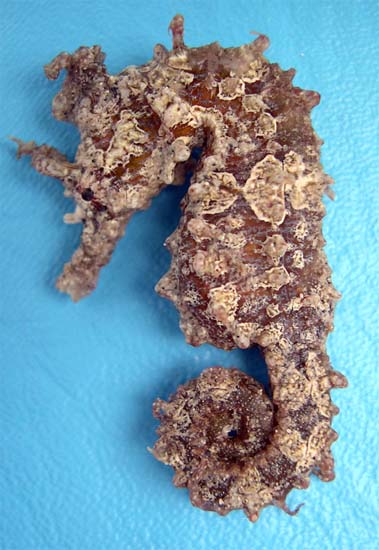
Distinctive Features
The large and hardy lined seahorse is deep-chested and robust. Instead of scales, this seahorse has skin that is stretched tightly over a bony armor that is arranged as a series of rings. At the end of the tubular snout is a small, toothless mouth. The gills are tufted and lobe-like with gill openings restricted to the upper border of the operculum. The pelvic and anal fins are absent, the dorsal fin is spineless, and the tail is prehensile. The coronet is variable and low and appears as a triangular wedge or ridge-like with sharp edges or spines. The first, third, fifth, seventh and eleventh trunk rings are enlarged which distinguishes it from other species of seahorses that typically have enlarged first, fourth, seventh, and eleventh trunk rings.
Coloration
The basic color of the lined seahorse varies from gray, orange, brown, yellow and red to black while brown specimens tend to be paler on their front side. The body often has a characteristic pattern of white lines following the neck contour from which this fish gets its common name of “lined seahorse”. Small white dots are located on the tail along with darker or paler saddles across the back.
Dentition
Seahorses lack teeth however they do have a long snout to accommodate their diet of small shrimp, very small fish, plants, and plankton which they swallow whole (see “Food Habits” section for more details).
Size, Age, and Growth
The maximum reported length of the lined seahorse is 7.5 inches (19.0 cm). Maturity is reached at lengths of 2.2-2.8 inches (5.6-7.0 cm) with males developing brood pouches at 5-7 months of age. The lifespan of this seahorse is approximately one year in length.
Food Habits
Seahorses are slow-moving so rather than chasing down prey, they use their elongated snout as a pipette to suck in small crustaceans including shrimp. Other prey items include amphipods, copepods, polychaetes, and gastropods.
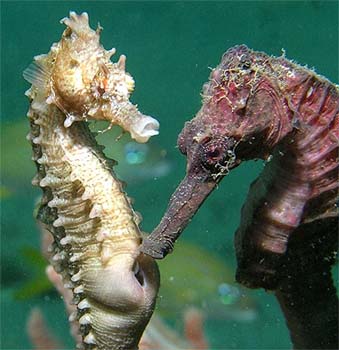
Reproduction
Seahorses are sexually dimorphic, with the presence of a brood pouch at the base of the abdomen of males the most obvious structural difference. Males also have proportionally longer tails than do the females. Mating with a single partner for an entire season or lifetime, the majority of seahorse species are sexually and socially monogamous. The courtship behaviors are complex with partners displaying changes in color becoming pale to whitish. The male inflates his pouch prior to pursing the female, signaling his readiness to mate. The female then transfers between 250-650 eggs to the brood pouch of the male which he then promptly seals and fertilizes the eggs. The brood pouch protects the developing embryos and provides them with oxygen through a capillary network. Development in the brood pouch is 20-21 days followed by hatching. The hatched embryos are carried within the pouch until they can actively swim. The father seahorse holds fast to an object with his tail, then bends backward and forward rapidly, opening the pouch to let a young seahorse out. These motions are repeated until the pouch is emptied. Each young seahorse emerges from the pouch head-first and able to swim freely. Each is an miniature copy of the adult lined seahorse, measuring about 0.4 inches (11 mm) in length. Lined seahorses reach their maximum size about approximately 8-10 months of age.Predators
In general, seahorses are believed to have few natural predators due to their ability to camouflage along with their unpalatable boney plates and spines. Although lined seahorses are well-camouflaged among aquatic vegetation, mobility is limited making this species somewhat vulnerable to predation. Larger fishes prey on adults and juveniles including dolphinfish, tuna, and sharks. In captive situations, parental males have been documented as cannibalizing small numbers of their own young.
Parasites
Captive lined seahorses are especially vulnerable to parasitic infections including microsporidians, including Glugea heraldi; a myxosporidian of the genus Sphaeromyxa; fungi; ciliates, including Uronema marinum; and nematodes.
Taxonomy
The lined seahorse was first described in 1810 by Perry as Hippocampus erectus. Synonyms include H. hudsonius DeKay 1842, H. punctulatus Guichenot 1853, H. marginalis Kaup 1856, H. laevicaudatus Kay 1856, H. fascicularis Kay 1856, H. villosus Günther 1880, H. stylifer Jordan & Gilbert 1882, H. kincaidi Townsend & Barbour 1906, H. brunneus Bean 1906. This fish is a member of the family Syngnathidae which includes seahorses along with pipefishes. The etymology of this family name is from the Greek syn meaning “with” and “together” along with gnathos translated as “jaw”. The genus name Hippocampus is derived from ancient Greek, translated as “horse/sea monster”. It includes three species of seahorses found in the western North Atlantic including the longsnout seahorse (H. reidi).
Prepared by: Cathleen Bester